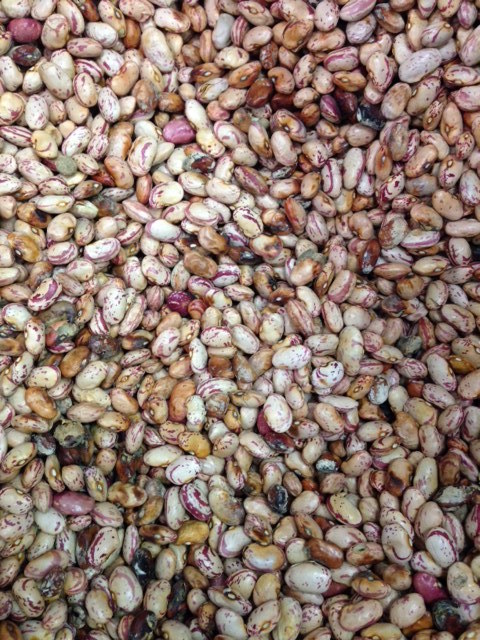The cranberry bean is also known as the borlotti bean, (among other names), and is a variety of common bean originating in Colombia as the cargamanto. It’s also known as the Roman bean and is popular in many Italian dishes.
Here is a page from Rancho Gordo, my favorite source of Heirloom Beans, that tells a bit about them. It’s worth running around on that website for great recipes, interesting stories and plenty of pretty pictures. One of the best things about Rancho Gordo is that they can help you overcome your fear (or perhaps just apathy or wariness) about cooking dry beans. They have a basic bean cooking method that I’ve found to be a sure-fire success every time:
Basic instructions for cooking beans in the Rancho Gordo manner:
There is not one single method of cooking beans. At its most basic, you want to simmer the pot until the beans are soft. Soaking can speed up the process and vegetables or stock will make them more flavorful. It’s really that simple. There’s all kinds of fine tuning and variables, but basically, this is it.
Normally on a bean cooking day (which frankly is everyday at Rancho Gordo), I put the beans to soak in the morning, after rinsing in lots of cool water and checking for small debris. I cover the beans by about an inch or so. If you haven’t soaked, don’t fret. Go ahead and cook them, knowing it will take a bit longer.
Heirloom and heritage varieties don’t need a lot of fussing if they are used fresh, which I’d define as within two years. You can use a ham bone, chicken stock or as I prefer, simply a few savory vegetables. A classic mirepoix is a mix of onion, celery and carrot diced fine and sautéed in some kind of fat, often olive oil. A crushed clove of garlic doesn’t hurt. If I’m cooking Mexican or Southwestern, I will sauté just onion and garlic in mild bacon drippings or even freshly rendered lard.
Add the beans and their soaking water to a large pot. You have been told before to change the water and rinse the beans. The thinking now is that vitamins and flavor can leech out of the beans into the soaking water you are throwing down the sink. There is conflicting scientific evidence that changing the water cuts down on the gas. If you want to, do it. If it seems unnecessary, don’t.
If you’ve soaked them, the beans will have expanded, so make sure they are still covered by at least an inch, maybe a bit more. Add the sautéed vegetables and give a good stir. Raise your heat to medium high and bring to a hard boil. Keep the beans at a boil for about ten to fifteen minutes. After so many years, I think this is the moment that really matters. You have to give them a good hard boil to let them know you’re the boss and then reduce them to a gentle simmer, before covering. I like to see how low I can go and still get the occasional simmering bubble. Open and close the lid, or keep it ajar to help control the heat and allow evaporation. The bean broth will be superior if it’s had a chance to breathe and evaporate a little.
When the beans are almost ready, the aroma will be heady. They won’t smell so much like the vegetables you’ve cooked but the beans themselves. At this point, I’d go ahead and salt them. Go easy as it takes awhile for the beans to absorb the salt. If you want to add tomatoes or acids like lime or vinegar, wait until the beans are cooked through.
If the bean water starts to get low, always add hot water from a tea kettle. Many believe that cold water added to cooking beans will harden them. At the very least, it will make the cooking take that much longer to bring them back to a simmer. We don’t recommend using hot tap water, straight from a water heater. Better to heat the tap water in a tea kettle or pan first.
So you’re done! Once you’ve mastered this method, go ahead and try some different techniques. Your bean friends will swear by this or that method and you should take their advice, keeping in mind there are few absolutes when it comes to cooking beans, only that it’s very hard work to mess up a pot of beans.
Here’s a printer-friendly PDF of Cooking Basic Beans in The Rancho Gordo Manner
Cooking beans in a crockpot:
Sauté half of a chopped onion in about one tablespoon of fat (oil, lard, bacon fat, etc.). Place in a crockpot along with any other aromatics you’d like (such as Mexican oregano, garlic, bay leaf), followed by beans that have been picked over and rinsed. Cover with water (about one part beans to three or four parts water). Turn the heat to “high” and give the contents a stir. Do this in the morning, and your beans should be done by the afternoon. Cooking time will be 4-6 hours, depending on your crockpot and the variety of beans.
Cooking beans in a pressure cooker:
First consult the manufacturer’s instructions for the exact method for your model. Place cleaned beans in the pressure cooker and cover with three or four parts water. Generally, you want to cook under pressure for 20 minutes, release, and then cook open on the stovetop for another 20 minutes.
Some handy cooking and storing tips:
- You can expect 1 cup of dried beans to yield about 3 cups cooked beans. One pound of dried beans (which is about 2 cups) will yield about 6 cups cooked beans.
- Our beans are so fresh that soaking is not needed. It will, however, speed up the cooking time and can help the beans to cook more evenly, so if you have the time to do it, it won’t hurt. We don’t recommend soaking more than 6 hours or the beans may begin to sprout.
- Many believe that adding salt (or acids like tomatoes and vinegar) too early in the cooking process prevents the beans from getting soft. We find this especially true with older beans.
- You can store leftover cooked beans in the refrigerator for up to 5 days and you can freeze them as well. If you are storing beans in the refrigerator, keep them in their cooking liquid so they don’t dry out.
- If a recipe calls for drained beans, be sure to save the extra liquid. You can use it for many things, including poaching eggs, adding moisture to dishes, and making soups.
- Store dried beans in a cool, dark place. It’s fine to keep them in their Rancho Gordo packaging, although some prefer to transfer them to a glass jar with a lid or an airtight container. They should be good for about 2 years. After that, they are still edible but the quality will begin to decline.

